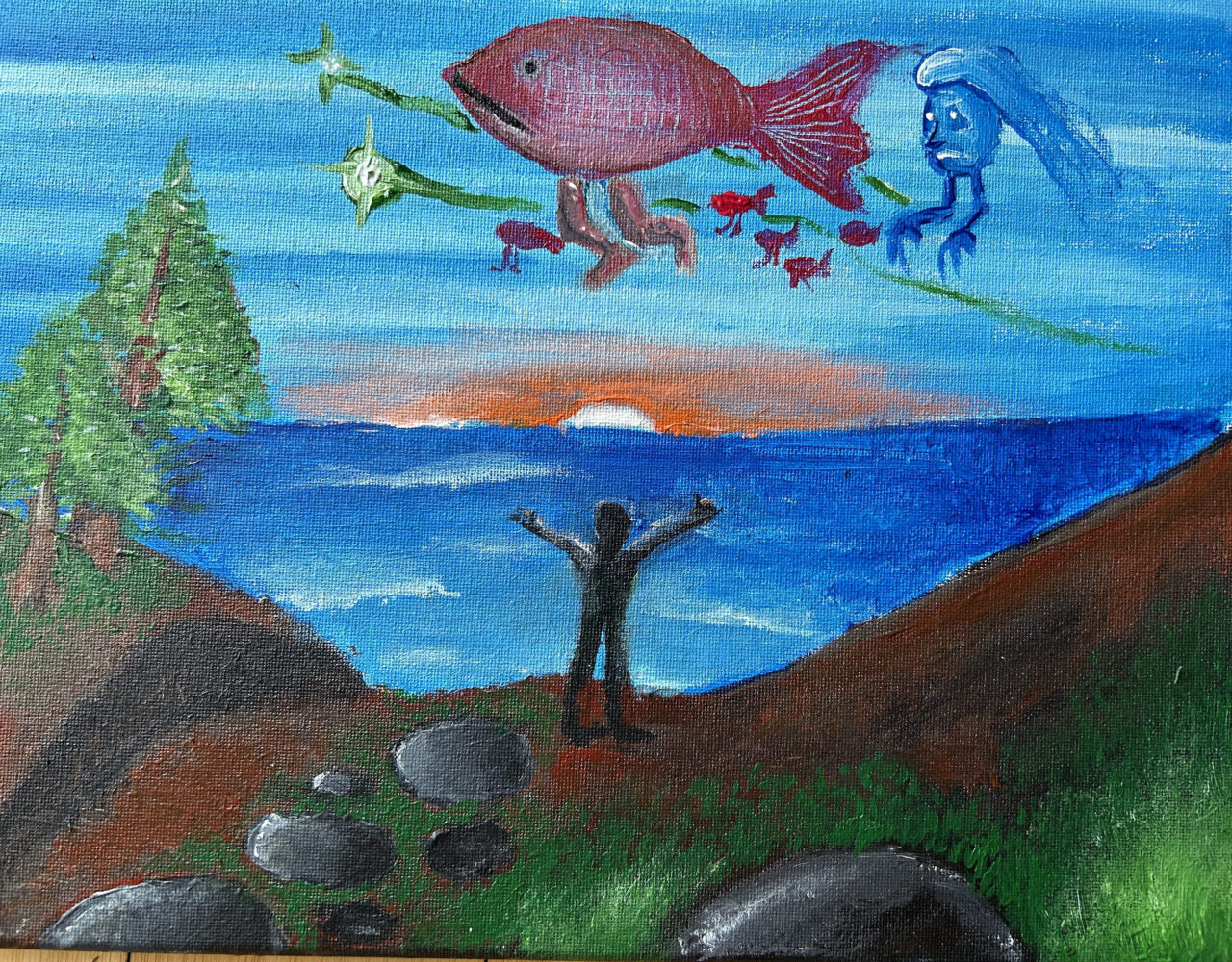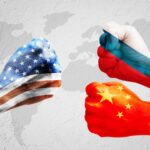Written by Charles Eisenstein
Death and life are the same thing, like the two sides of my hand, the palm and the back. And still the palm and the back are not the same. They can be neither separated nor mixed.
— Ursula K. Le Guin
I was driving my son Cary, age 10, to a small gathering where some buddies and I do our cold plunge in a frozen pond. We were discussing safety. Our friend is a substitute teacher in the public school system. Safety is the top priority, and “safe hands” is the constant refrain of each day of behavior management. I told Cary of my favorite motto (which I’m told derives from Burning Man), “Safety third.” Of course, that motto does not mean to imply a linear ranking of life’s priorities. Its commonsense translation would be something like, “Safety is important, but not the most important thing in life.”
Cary, taking the saying literally, asked me, “If safety is third, then what comes first and second?”
I hesitated for several seconds. Then I said, “First and second are giving and receiving, not necessarily in that order. Giving is what you put into the world. It is your art and music, it is your mom’s healing work, it is the love you show to others, it is everything you do to make the world more alive and more beautiful.”
“Receiving is to fully enjoy being alive in this world. It is to behold with awestruck wonder the magnificence of creation. It is to delight in the gifts of others, and the animals and plants and the sky, the singing of the birds, the creativity of other people, to play and enjoy. As your grandmother said before she died, ‘Life has so much to offer!’”
Cary was well satisfied with this answer. I then added, “It isn’t that safety is unimportant. If you break your leg or have a fatal accident, then you won’t be able to give or receive in this world anymore. But safety is subordinate to giving and receiving. It must not come before them. We are here to be fully in the world, to live fully, not to play it safe and go to our graves having never risked anything.”
I first publicly invoked the phrase “safety third” at some point in 2021 or 2022, in the context of Covid. I was a little taken aback by the vehemence of some of the responses. People accused me of being selfish, lacking compassion, and not caring about others. I will paraphrase the criticisms: “By ignoring safety and not masking and vaccinating, by leaving your home and questioning public health measures, you are putting others at risk for your selfish ‘freedom.’ Furthermore, even if you are risking only your own safety, that still imposes a cost on society. If you fill up a hospital bed due to your risky behavior, you are denying that bed to someone else.”
Let us leave aside the fact that “freedom” is not first, second, or third on my list—not as a disembedded ideal, anyway. Freedom is intelligible only as freedom from, or freedom to. Freedom to give and receive. Freedom to be alive. But I don’t want to make this a question of freedom, because, contrary to media narratives, freedom was never the main motivation of so-called “anti-maskers” and “anti-vaxxers.” We thought these were bad policies, founded on hysteria, captured science, and systemic ideology, then exploited by authoritarian forces as a pretext for more social control. Compassion and concern for the public welfare were the main motivations of our dissent.
The argument cited above takes for granted exactly what I mean to challenge with the words “Safety third.” Now, I do not think masking, lockdowns, and the vaccines actually saved lives, but what if they did? What if we could save a thousand lives a year (that is, postpone a thousand deaths a year) by mandating a permanent lockdown society. Should we do that? What if we could save fifty deaths a year, and reduce hospital bed occupancy, by prohibiting swimming at the beach. Should we do that? No? Tell that to the grieving mothers of the children who drown and the spouses of those who get skin cancer from too much sun exposure. Early in the pandemic, Anthony Fauci and other public officials said we should never hug or shake hands again. Filthy habit, isn’t it. Well, all of these ideas make perfect sense if we install safety as our god. But we are here to live, not to survive life. We are here to play in the waves, to hug, to associate with each other, to live in materiality with all its inherent risks. I do not call on others to take risks that do not serve giving or receiving—that is called recklessness, not courage—but neither does anyone have the right to demand that others, or society at large, curtail life to minimize risk.
Since most people today behave as if they have forgotten that the Covid pandemic ever happened, I won’t belabor Covid-era issues. I raise them mostly as a case in point, the point being the politically hazardous and spiritually deadening effects of the obsession with safety.
The political hazards are obvious. Authorities can manipulate a safety-obsessed population by conjuring up one threat after another. Safety as top priority justifies any measure that will keep you safe. Safety first, civil liberties an afterthought. We saw a foreshadowing after 9/11 of what was to come in 2020. First it was “security,” then it was “health” that justified new extensions of centralized power. Eventually though, both terrorism and pandemic lost their ability to terrorize, and thus their usefulness as pretexts for totalitarian policies (surveillance, censorship, propaganda, etc.). However, the social and psychic conditions for a new fear campaign remain in place.
It is equally obvious why safety-obsession deadens the spirit. It wraps a constriction band around life. It is always a little dangerous to probe one’s boundaries. It is always a bit dangerous to venture into the unknown. “Safety first” shrinks the horizons of possibility. What starts as caution becomes comfort, then habit, then a prison. The prisoner carries the key in his back pocket, taking comfort in his pretend helplessness. I’m not lecturing you, I’m speaking from personal experience. One feels less and less alive. What is there to live for, confined to the fortress, looking wistfully out the windows at a lush but distant landscape?
It is pointless to denounce safety-obsession without investigating its source. Under what conditions does avoiding injury and death become the point to life? Put that way, safety obsession is exposed as a form of insanity. It makes sense only if one is in denial of his or her mortality. It is no wonder then that our society performed such extreme rituals of protection during the pandemic. We are a culture that paradoxically and simultaneously denies death even as we make it the subject of the most extreme dread. We deny it by hiding it behind euphemisms, by banishing the public and private sight of it, by performing pointless heroics to extend the lives of dying people a few more torturous weeks or days, as if to thwart something preventable. Most of all, we deny it through distance, living apart from nature’s cycles, never witnessing the rabbit’s writhe and shriek in the hawk’s talons. Yet for all the denying and distancing, death looms all the larger on our psychic landscape. Its terror comes in large part from separation from life. The separate individual of modern self-conception goes extinct on dying. The relational, interdimensional self of indigenous conception cannot be extinguished, since what dies is but a small part of the true self. For the modern mind, for the separate self, death is a final and unutterable catastrophe, too terrible to countenance. So of course we become obsessed with safety, as if to reassure ourselves that with proper care, the ultimate calamity need never happen.
There is another cause of safety obsession that is more important still. If safety rises from third to first rank, one wonders, what happened to the first two? What happened to giving and receiving? Beneath “safety first” lies a cultural forgetting, an abdication even, of the true purpose of the human being. It isn’t hard to see that we as a society have largely abandoned our devotion to life and beauty on earth, and built instead a civilization that mars and ruins creation. Less obvious but more tragic is the narrowing and numbing of our receiving. We have become too busy, too distracted, too alienated, too hurting to fully receive the magnificence of all we can see, hear, feel, and praise. Full reception is a function of intimacy, and modern life has dulled the vividness and intimacy of our connections. Taking in only a tiny fraction of the sensory nourishment we need, we are forever hungry, craving ever more intense stimuli to meet the need to feel. Addiction, then, is not a failure of character or will. It is a sign of a real unmet hunger.
Please do not read any of this as a condemnation. It is more a diagnosis. Recruiting shame to motivate change won’t restore our aliveness. What will? Grief. Grief is the embodied realization of loss. If we can recognize the magnitude of our loss, the profundity of our dispossession, we will turn in a new direction. We will have full information. Without feeling grief, we don’t really know what has been and will be lost. Grief integrates what is lost as precious. Grief makes death real.
We have wandered far, far, far into the territory of separation. We must admit that we are lost. We dissolve in tears. We turn then and see on the horizon the golden land. Only teary eyes can see the path back.















